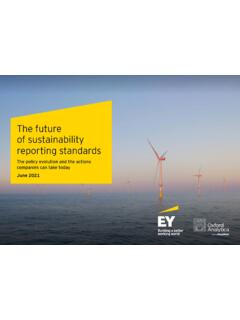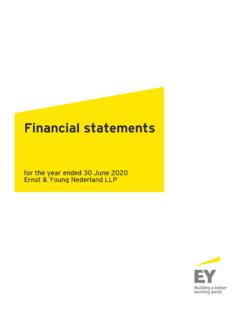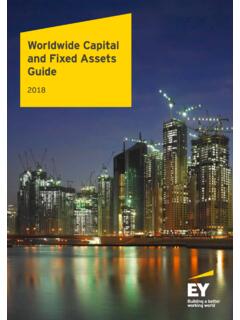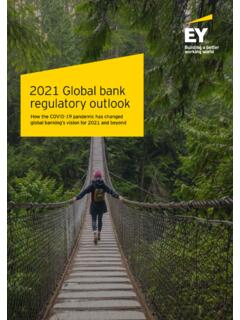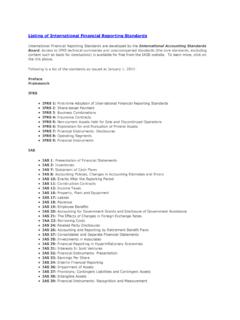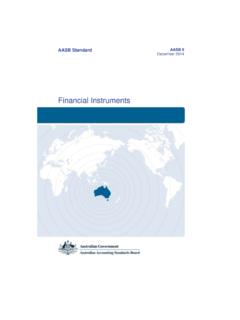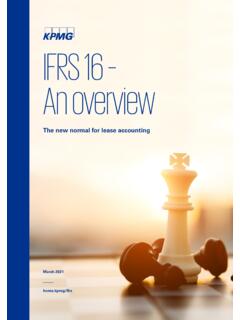Transcription of IFRS 9 Expected IFRS 9 expected Credit Loss credit loss
1 ifrs 9 Expected Credit LossMaking sense of the change in numbersIFRS 9 Expected Credit lossMaking sense of the transition impactContentsExecutive summary 1 Main features of the ifrs 9 ECL model 2 Availability and granularity of ECL disclosures 3 Overall ECL transition impact 4 ECL transition impact for Credit -impaired loans 6 ECL transition impact for the good book 8 Regulatory impact 10 Towards enhanced transparency 121 ifrs 9 Expected Credit loss Making sense of the transition impactExecutive summaryThe transition to ifrs 9 generally resulted in an increase in impairment allowances. The impacts on financial statements and CET1 ratio are, in most cases, lower than previously estimated, reflecting in part more favourable economic a few exceptions, allowances for Credit -impaired loans remained fairly stable compared with IAS 39, which already required estimation of lifetime Expected losses for these exposures.
2 For non-impaired loans, ECL allowances are generally higher than IAS 39 collective allowances. Significant differences in transition impacts appear between banks, including at the country level. Many of the factors that explain these differences are typical drivers of changes in impairment, such as the bank size, its portfolio mix and geographical footprint. Transition impacts also reflect different judgements and estimates in terms of ECL methodological choices and forward-looking scenarios. In addition, several factors not related to the ECL approach had a significant impact on transition, such as reclassifications, write-off policies, and the treatment of purchased and originated Credit -impaired (POCI) drivers and their complex interactions illustratesome of the challenges ahead for banks in explainingchanges in allowances and for financial statements users inunderstanding ifrs 9 financial Instruments2 EY ifrs 9 Impairment Banking surveys This analysis is focused on ECL allowances for loans.
3 Exposures resulting from cash in bank accounts, securities, guarantees and Credit commitments were excluded whenever they were disclosed 9 Expected Credit loss: making sense of the transition impactFor banks reporting under International financial Reporting standards ( ifrs ), 1 January 2018 marked the transition to the ifrs 91 Expected Credit loss (ECL) model, a new era for impairment road to implementation has been long and challenges remain. EY supported banks throughout the implementation journey with a series of annual surveys that provided state of readiness benchmarks and implementation publication complements the series of surveys with a quantitative analysis of the transition to ECL in terms of impact on the financial statements3 and Core Equity Tier 1 ratio (CET1 ratio).
4 Beyond the change in numbers, it discusses the main factors that explain differences between banks and analysis was conducted on a sample of large banks representing continental Europe, the UK and Canada. Although presented on an anonymous basis, it is entirely based on publicly available information, such as 2017 annual reports, ifrs 9 transition reports and Q1 2018 quarterly 1: Sample of banks, by countryCanada (CA)France (FR)Germany (DE)Italy (IT)Netherlands (NL)Spain (SP)Switzerland (CH) United Kingdom (UK)Number of banks0123452 ifrs 9 Expected Credit loss Making sense of the transition impactUnder IAS 39, impairment allowances were measured according to an incurred loss model wherein the recognition of Credit loss allowances was triggered by loss events subsequent to origination.
5 Losses incurred but not reported were evaluated using diverse provisioning approaches, varying between banks and new ifrs 9 impairment model requires impairment allowances for all exposures from the time a loan is originated, based on the deterioration of Credit risk since initial recognition. If the Credit risk has not increased significantly (Stage 1), ifrs 9 requires allowances based on 12 month Expected losses. If the Credit risk has increased significantly (Stage 2) and if the loan is Credit -impaired (Stage 3), the standard requires allowances based on lifetime Expected losses. The assessment of whether a loan has experienced a significant increase in Credit risk varies by product and risk segment.
6 It requires use of quantitative criteria and experienced Credit risk judgement. As opposed to IAS 39 which required a best estimate approach, ifrs 9 requires multiple forward-looking macro-economic and workout scenarios for the estimation of Expected Credit Accounting standards Update 2016-13, financial instruments Credit Losses (Topic 326), Measurement of Credit Losses on financial GAAP perspectiveThe US financial Accounting standards Board (FASB) published a new impairment standard4 based on current Expected Credit losses (CECL) in 2016, which significantly changes accounting for Credit losses for most financial assets and certain other instruments that are not measured at fair value through net income.
7 The earliest effective date is the beginning of 2020 for calendar-year entities that meet the definition of a public business entity. Early adoption is permitted for all entities beginning in 2019. Similar to ifrs 9, the FASB s model is forward-looking, no longer requires a trigger event for the recognition of impairment allowances and should be based on reasonable and supportable information. The two standards differ the most in terms of the period over which losses are measured and recognised. The FASB s model requires measurement of lifetime ECL from the time of loan origination. Compared to ifrs 9 staged approach, this leads to a higher Expected impact on transition to features of the ECL model3 ifrs 9 Expected Credit loss Making sense of the transition impactFigure 2: Sources of ECL informationWhile several sources of information currently provide insights on the ifrs 9 impact on loan provisions, their granularity and level of detail vary, in some instances due to country-specific and granularity of ECL disclosuresThe first ECL disclosures provided in year-end (YE) 2017 annual reports were high-level estimates of the increase in loan allowances and impact on CET1 ratio.
8 In the UK, shortly after the yearend, banks published ifrs 9 transition reports , a comprehensive set of accounting and regulatory disclosures. These reports explain the impact of ifrs 9 on classification, measurement and loan allowances, and include deep dives on exposures and provisions by stage, business line and product. Besides UK banks, two other European banks published transition reports on a voluntary basis. Some banks in the sample, such as Canadian, German and Swiss banks have published Q1 ifrs accounts, which include full ifrs 9 transition disclosures and most business-as-usual disclosures, including breakdowns of exposures and ECL allowances per stage, as well as changes in ECL allowances over the the time of writing, some banks in the sample had solely provided revised impact estimates and limited transition information in their Q1 financial communication and as a result, are not included in some of the figures presented in this majority of banks published IAS 8 disclosures.
9 High-level estimates of the ifrs 9 impact on the financial statements Impact on CET1 ratioUK banks and two other European banks published ifrs transition reports: Detailed transition disclosures Business-as-usual disclosures on balance sheet, exposures, risk estimatesCanadian, German and Swiss banks published Q1 ifrs financial reports: Detailed transition disclosures Some business-as-usual disclosuresSome banks provided more detailed information than in YE 2017 annual reports: Updates of YE 2017 impact estimates Detailed transition information in Q1 2018YE 2017 annual reportsTransition reportsQ1 2018 ifrs quarterly reportsYE 2017 and Q1 2018 financial communication4 ifrs 9 Expected Credit loss Making sense of the transition impactFor the majority of banks analysed, the transition to ifrs 9 generally results in an increase in allowances, ranging from a few millions to EUR4 billion (Figure 3).
10 This transition impact analysis is focussed on some of the key indicators that we expect financial statement stakeholders will use to compare banks under ifrs 9, such as the level of provisions, coverage ratios and equity impact upon size is a significant contributor to the magnitude of the increase in loan allowances (Figure 4). However, there are notable exceptions. Some point to the multitude of factors that typically trigger changes in loan provisions, such as the bank s product mix and its geographical footprint. Others include regional trends in IAS 39 provisioning practices and differences in the significant judgements involved in the ECL methodology. Portfolio mix: Generally, retail portfolios experienced larger increases in loan provisions.
